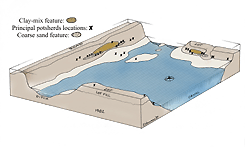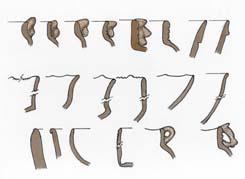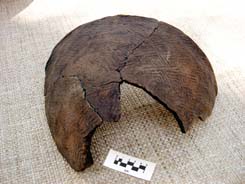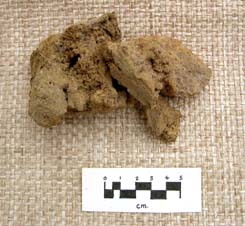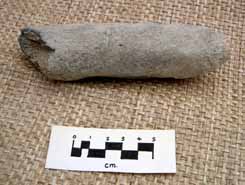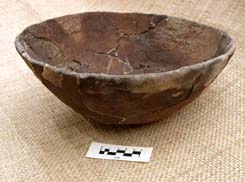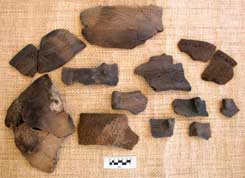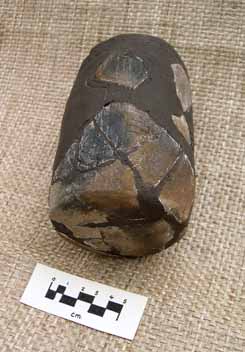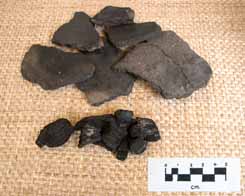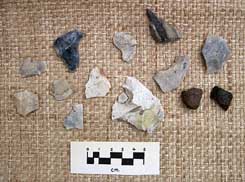by Frank D. Howard & Susan Sapronetti
© 1998
click any photo for larger view
Lifelong interests in both the discovery and preservation of things historic have pervaded our many treks into various areas of the Southeastern United States. There have been times when the size or significance of a find prompts notification of some authority. One such find in 1982, which prompted a call to the Florida Division of Historical Resources, is described below. The call to report this find we thought would evoked a response indicating a lack of interest due to the area having been disturbed twice in the past by dredging. Nevertheless, the material and features found seemed worthy of some attempt at preservation and notion.
This site was located along the Florida panhandle coastline in Wakulla County. Spoil dredged from an adjacent canal was used as fill on recently acquired coastal property. In this layer of fill a number of potshards were discovered as water pipes were installed and other ground work completed on the property. Also, during periods of low tide, many large pottery shards were recovered from the tidal wash on one side of the canal and some 12 meters away, along the drainage ditch that crosses the end of the canal. ( figure 1)
At various intervals over the next few mouths approximately two cubic feet of potsherds were collected and sorted. During one of these collecting forays after a storm had caused damage to the canal and ditch walls, two features were noticed: a large clay deposit and a small distinct layer of coarse silica sand.
Most of the shreds came from two separate small areas only 3 to 4 meters apart along the ditch and 8 to 10 meters along the canal. Between these two sites a deposits of clay, the first feature, was exposed some 4.5 meters along the ditch bank (approximately one meter thick at the thickest part) and one meter by one third meter along the canal side. Inspection of several samples showed the clay to contain a high percentage of both tiny (<5 mm) pottery fragments and coarse (>0.5 mm) quartz sand grains. Simple washing of clay samples taken from different locations within the clay feature yielded an approximate average of 20% coarse sand/pottery fragments and 16% fine (>0.5mm) sand/pottery fragments.
The second feature was a thin band of coarse sand 1.5 meters along the canal and a similar band along the ditch bank. These sand Features were observed in positions below and adjacent to the clay feature.
Most of the shreds found are grog and coarse sand tempered, and have a dark core with what appears to be a light tan slip - the result of a low oxidizing fire. Also found were fine sand tempered sherds, reddish colored sherds, orange surfaced and white surfaced dark cored sherds. Most of the sherds are from plain undecorated vessels ranging from shallow, wok - like bowls with thin lips (figure 2) to simple, thick lipped bowls. Others are small Ft. Walton Plan and Ft. Walton Incised bowls with rim lugs, and a few with loop handles (figure 3 and 4). Also found were Leon Check Stamp and Jefferson Ware, both diamond (figure 5) and curvilinear complicated stamped varieties. Incised wares include an unusual beaker (figure 6). Among the finds were sherds from three different vessels which appear to have unfinished surfaces. The ceramics are from the early Leon - Jefferson period, and do not show any evidence of Spanish influence in the form of copy ware.
Among the sherds, lumps of charcoal, bone fragments, lumps of partially fired clay-mix for making ceramics, flakes of chert and burned shards were found (figures 7, 8, 9, 10). One piece of fossil bone, 14x5x3cm, was found among the potsherd stacks with the 3cm face of smoothed open chancellors bone filled with the ceramic clay-mix. The most of the flakes of chert had one smoothed surface. These flakes where most likely used as a tool in smoothing sides of a clay pots.
In 1984, after a storm had removed much of the clay feature, several clusters or "stacks" of sherds were exposed. Noting that some of the stacks consisted of individual vessels, efforts were made to collect sherds immediately below the surface to recover the entire stack. Four vessels have been assembled from the sherds collected at that time: two plain round bottomed bowls, one Jefferson Ware (diamond stamped, Figure 5) and one incised beaker (figure 6).
A small spring exists some 200 meters away, where it was cut into by the dredging process which formed the ditch. It is possible that this spring feed a stream, the bed of which is now marked by the thin layer of coarse sand. The largest number of sherds were exposed on top of the sand layer along the clay feature. The position and proximity of many of the potsherds stacks suggests utilizing potsherds for clay containment (along the sides and bottom). The volume of clay mix seems to indicate a large amount of pottery to be made.
The manner in which the potsherds were collected (most exposited in the tidal action) allows no more than speculation as to why shards from different types are found together. For instance, why did the feature near the road contain mostly plain potshards, while that on the lot had mostly decorated potsherds? (see figure 1) From our observations and the sheer volume and consistency of the clay mix exposed, we are of the opinion this site is one where pottery was formed and fired. This also tells us this site was in use over a period of time.
Over time, tidal washes, storms, and hurricanes this small site has now washed away. The significance of the information provided by our observations and the artifacts collected may appear small, but when put in context with the many other findings in this area may be of value in completing an overall picture of the history of North Florida.
 Figure 11: Artist rendition of site |
